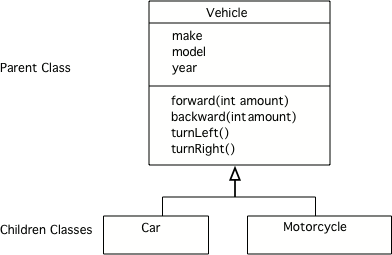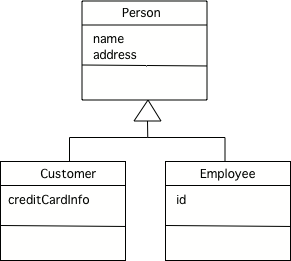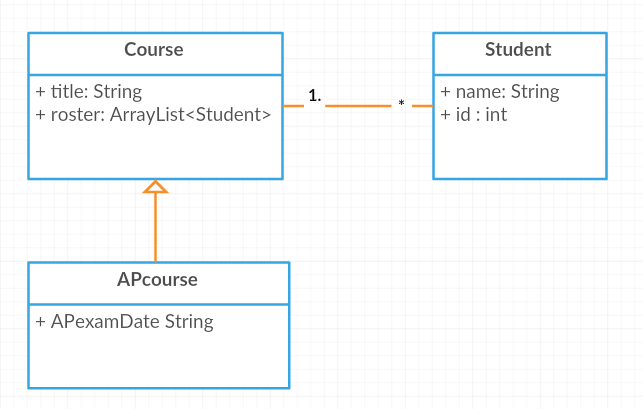📓9.1: Class Inheritance
Table of Contents
📖 This page is a condensed version of CSAwesome Topic 9.1
📓DEMO PROGRAM SETUP INSTRUCTIONS
- Go to the public template repository for our class: BWL-CS Java Template
- Click the button above the list of files then select
Create a new repository - Specify the repository name:
CS2-Unit-9-Notes - Click
Now you have your own personal copy of this starter code that you can always access under the
Your repositoriessection of GitHub! - Now on your repository, click and select the
Codespacestab - Click
Create Codespace on mainand wait for the environment to load, then you’re ready to code! - 📝 Take notes in this Codespace during class, coding along with the instructor.
Class Inheritance
One of the really useful features of Object-Oriented programming is inheritance.
You may have heard of someone coming into an inheritance, which often means they were left something from a relative. Or, you might hear someone say that they have inherited musical ability from a parent.
In Java all classes can inherit attributes (instance variables) and behaviors (methods) from another class. The class being inherited from is called the parent class or superclass. The class that is inheriting is called the child class or subclass.
When one class inherits from another, we can say that it is the same kind of thing as the parent class (the class it inherits from).
For example, a car is a specific kind of vehicle. This is sometimes called the is-a relationship, but more accurately it’s a is-a kind of relationship. A motorcycle is another kind of vehicle. All vehicles have a
make,model, andyearthat they were created. All vehicles can goforward,backward,turnLeftandturnRight.

A UML (Unified Modeling Language) class diagram shows classes and the relationships between the classes as seen above. An open triangle points to the parent class.
The parent class for
CarandMotorcycleisVehicle. TheVehicleclass has two child classes or subclasses:CarandMotorcycle.
Subclass extends Superclass
To make a subclass inherit from a superclass, use the Java keyword extends with the superclass name when creating a new subclass as shown below:
public class Car extends Vehicle {}
public class Motorcycle extends Vehicle {}
While a human can have two parents, a Java class can only inherit from ONE parent class. If you leave off the extends keyword when you declare a class, then the class will inherit from the Object class that is already defined in Java.
Why Use Inheritance?
Inheritance allows you to reuse data and behavior from the parent class. If you notice that several classes share the same data and/or behavior, you can pull that out into a parent class. This is called generalization.
For example,
CustomersandEmployeesare both people, so it makes sense use the generalPersonclass as seen below.
Inheritance is also useful for specialization which is when you want most of the behavior of a parent class, but want to do at least one thing differently and/or add more data. The example below can also be seen as specialization. An employee is a person but also has a unique id. A customer is a person, but also has a credit card.

The Student class can also inherit from the class Person just like Employee and Customer because a Student is a type of Person.
- 💻 FIX CODE: What do you need to add to the
Studentclass declaration below to make it inherit from typePerson?When you fix the code below, the
instanceofoperator would returntruethatStudent sis an instance of both theStudentand thePersonclass.
public class Person {
private String name;
}
public class Student {
private int id;
public static void main(String[] args) {
Student s = new Student();
System.out.println(s instanceof Student);
System.out.println(s instanceof Person);
}
}
- 💬 DISCUSS: What other private instance variables could you add to
PersonandStudent? In which class would you put an address attribute? Where would you put GPA?
IS-A vs. HAS-A Relationships
Another type of relationship between classes is the association relationship, or “HAS-A” relationship. Use this when the object of one class contains a reference to one or more of another class.
For example, a course can have many course periods associated with it as shown below:

The
1near theCoursemeans that1course object is associated with the number shown near the other class. In this case it is*, which means “0 to many”. So one course is associated with 0 to many course periods.
In the code, the Course class has an array or ArrayList of CoursePeriod objects as an attribute (instance variable inside it:
public class Course {
private ArrayList<CoursePeriod> periodList;
}
Alternatively, we could say that a CoursePeriod has-a Course attribute inside it to hold the information about the course.
It is up to the programmer how to design these two classes depending on which type of association would be more useful in the program.
public class CoursePeriod {
private Course courseInfo;
private int period;
}
Here is another example. Consider the classes Student, Course, and APcourse. An APcourse is a specialized type of Course. Students register for Courses. So what are the relationships between these classes?

The UML diagram above shows:
- The inherits (IS-A) relationship between
CourseandAPcourse- The associate (HAS-A) relationship between
CourseandStudents.
is-a Substitution Test
If you aren’t sure if a class should inherit from another class ask yourself if you can substitute the subclass type for the superclass type.
For example, if you have a Book class and it has a subclass of ComicBook does that make sense? Is a comic book a kind of book? Yes, a comic book is a kind of book so inheritance makes sense. If it doesn’t make sense use association or the has-a relationship instead.
Only use inheritance (is-a) when the child class is truly a type of the parent class, otherwise use association (has-a).
💻 In-Class Activity: Online Store
⭐️ Summary
-
A class hierarchy can be developed by putting common attributes and behaviors of related classes into a single class called a superclass.
-
Classes that extend a superclass, called subclasses, can draw upon the existing attributes and behaviors of the superclass without repeating these in the code.
-
The keyword extends is used to establish an inheritance relationship between a subclass and a superclass. A class can extend only one superclass.
- Extending a subclass from a superclass creates an is-a relationship from the subclass to the superclass.
🛑 When class ends, don’t forget to SAVE YOUR WORK!
- Navigate to the
Source Controlmenu on the LEFT sidebar - Type a brief commit message in the box, for example:
updated Main.java - Click the button on the LEFT menu
- Click the button on the LEFT menu
- Finally you can close your Codespace!
Acknowledgement
Content on this page is adapted from Runestone Academy - Barb Ericson, Beryl Hoffman, Peter Seibel.